Megan Rieker
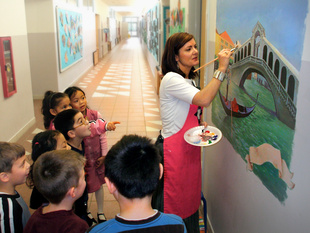
How did you get started in painting and art?
I started off in my younger years rushing through assignments in school because if you finished before everyone else, you could get blank paper and draw. By middle school I was in art club but was pretty bad—I loved art so much, though, so I kept at it. After my freshman year at high school I was pretty depressed and had low self-esteem. I would spend hours drawing something, crumple it up in a fit of anger when it didn’t turn out right, and throw it in the trash. Later, I’d usually sneak back and get my paper out, until the one time Mom poured some hot oil in the trash, ruining the drawing for good. I learned a lesson that time!
My wonderful mother took it upon herself to help me find a way out of my self-pity rut and found an audition for a brand new magnet school of the arts an hour away in Suitland, Maryland. I brought in my Dungeons & Dragons type of drawings and my most recent paintings, which I had done—of all things—ala Bob Ross. It’s probably a good thing the man that interviewed me wasn’t an artist himself—they were that bad—with “happy little trees” and lots of fan brushwork.
But I was accepted and from then on everything changed. I was around people who understood me, my grades skyrocketed, and I felt like I was someone special. Coming from a family of eight, college was a little uncertain, but because of that high school, I was blessed to get scholarships to Maryland Institute College of Art in Baltimore. Through all those years my parents were so supportive! My dad, who is very creative himself, especially worked and sacrificed much in finding ways for me to stay at school every semester.
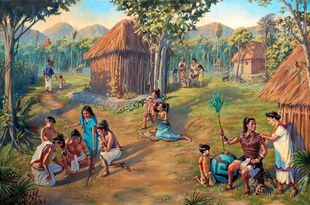
How did you find Elizabeth Horrocks Jackson’s story?
I love to read! Gerald N. Lund’s book The Fire of the Covenant was written so well that I could visualize the characters in the Martin and Willie handcart companies. I had already been on the lookout for the next woman to portray in my “Women of Inspiration” painting series, and when I read about Elizabeth Jackson I wanted to learn even more about her. I found her memoirs and was even more impressed with her story of faith during extreme circumstances. I was moved to portray her the night before the rescue company came—when she had almost given up hope but prayed to Heavenly Father, “He who had promised to be a husband to the widow and a father to the fatherless. I appealed to him and he came to my aid.”
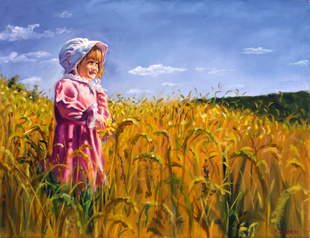
In “Born for Such a Time as This,” what made you choose to portray the young Esther?
Every time I start searching for the next woman to portray, I pray and read my scriptures, listen to more talks, and stay alert for the inspiration to come. It’s often through my scripture study or the words of a visiting teacher or friend that I get my answer. Something kind of “clicks” deep within me and I know whom to paint.
For the Esther painting there were many things that endeared her to me. First of all, my sweet Grandmother Fulcher was named Esther, and my middle name is also Esther. Like so many of us, she was put in a certain place and time and position to help her brothers and sisters. In researching Esther, I found that she would have been a fairly young teenager, yet she showed bravery and faith and leadership as she strengthened herself for this trial by fasting, praying, and consulting her elders. I love to see women like Esther who are ready to be used as a vessel for the Lord.
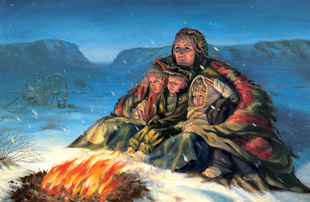
As you have done this series, how has your increased knowledge and understanding of these women inspired you?
I think a commonality in all the women in this series is that they each had a store of faith in God that either sustained them or inspired them as they went through their trials. President Kimball said “faith precedes the miracle,” and through the stories of these faithful and courageous women, we can see for ourselves how God blesses each of us, no matter how big or small the challenge may seem, if we have faith, his miracle will come—not ours, but his.
Doing this series—painting all these inspiring, faithful women—has also been teaching me about being a vessel for my Heavenly Father myself. I have noticed that when I live my life as I should, my brush is guided and the decisions are easier. But when I am weak and make bad choices, my hand is not guided and painting becomes much harder. One of my favorite quotes is “Beware of what you consume and produce… It becomes a part of you.” By surrounding myself with visual examples of the faith and testimony of these women, I am continually reminded of how small my problems are in relation, and how much is expected with what I’ve been given.
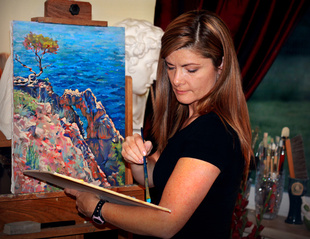
In “Waiting at the Seoul Temple” you say that you lived in South Korea for a year. What took you there?
That one is a simple answer! My husband is a pediatrician for the Air Force and so for the past nine years we have lived overseas in places such as Osan, South Korea; Ramstein, Germany; Aviano, Italy; and now we are finishing up our time in Spangdahlem, Germany. It’s been wonderful to travel and see and paint beautiful places and also to make new friends around the world. And every time we venture into an LDS meetinghouse other than our own, there is always a feeling of having been there before and instant friendships. We miss the U.S. and our family, though, and look forward to coming back soon.
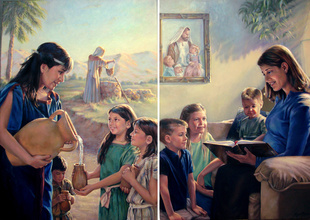
Also from that same piece: How did you get to know Sister Ho, who was the first living sister portrayed in your “Women of Inspiration” series?
As we grew to love the culture and history of Korea, I felt strongly about capturing the faith of the early saints (the church was celebrating its fiftieth year in South Korea while we were there) and their endurance. Our good friend and district president, John Madsen, and Brother Han Insang brought Sister Ho to my attention. At first I was unsure about painting a living sister as part of the series, but after meeting her and speaking through interpreters I saw how genuinely humble and faithful she is, and after learning of her story, I was convinced. Sister Ho is well known among the longtime LDS of Korea. She had survived much, including a bus accident in Seoul that crushed her legs. Some years before I met her she was having such difficulty with her legs that she prayed one night for them to be healed and promised that she would give of herself to the temple. The next day she awoke with no pain. Sister Ho spent the next few years attending session after session, day after day in the Seoul, Korea Temple. This sweet little woman who only comes up to my shoulder was able to do the work for 2,200 people! Sister Ho had the faith that is representative of many South Koreans I’ve been honored to meet. It was a pleasure to meet and portray such a wonderful daughter of God.
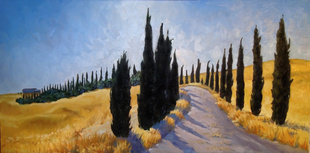
You mentioned that for “Our Mothers Knew It” painting, that you travelled to Mexico for research. Can you tell us more about that experience?
It was a really neat experience, and it was new for me not only to portray women from the Book of Mormon, but also to walk in those lands and see the ruins. It took over six months to do research, make sketches, and even sew the costumes with my sister.
Then my husband Mark and I took the kids to a sitter and flew from our home in Italy to Cancun, Mexico, where we met our guide, Helaman Petlacalco, who took us to a small village of Mayan descendants. As we drove on the dirt road, avoiding various animals and children, we saw that their houses were still made in a hut type of style—with grasses and palms for the roof and thin pieces of wood for the walls. Helaman said to us, “This is not too different from how many of the Book of Mormon people lived…well, except for the satellite dish.” And sure enough, on top of one of the teeny huts was a satellite dish. We all laughed in surprise.
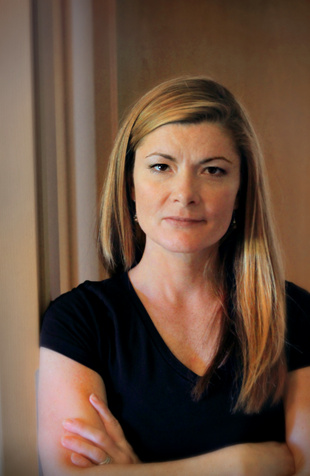
Because I had a limited window of time to take the pictures (so the lighting would match) I would pose one grouping at a time, showing them the sketches to give them an idea for each pose. The men and women were wonderful following the sketches and a bit on the giggly side, especially about the loincloths! Because these were not members, it was pretty unusual for them, but Helaman did a great job explaining. When we were finally done with the photos we played around for a while; the kids tried on the wigs and played with some cute yet irritating whistles I had brought for them (the parents may hate me for that!). After the painting was finished and prints were made, it was arranged for small prints to be delivered inside of copies of the Book of Mormon to the village. I still haven’t heard anything about them, but hopefully a seed was also planted during that experience.
Also as part of your research for “Our Mothers Knew It,” you mention the stone friezes that you use in the painting. What was it like seeing those carvings in person?
You know, I saw so many different carvings or Mayan hieroglyphs while I was there, but it wasn’t until much later—towards the end of the painting—that I decided to add a message in the base of the house. But being able to touch those stones and imagine someone chiseling them all those years ago was fascinating! The one piece I would have loved to see but didn’t was the giant eight-foot carving of Lehi’s dream, attributed to the time of Nephi. But I thought it was so wonderful that I have one of the mothers drawing it for the men in the forefront of the painting.
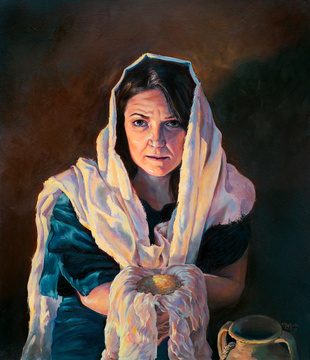
You also emphasize that you are inspired to create each of these paintings. Could you share one of those inspiration stories?
Perhaps I can explain my inspiration best by first telling you how the “Women of Inspiration” series was started.
I had already graduated with my master’s degree in Teaching Art from MICA and had taught for a year in elementary schools in Maryland. While my husband Mark went to medical school and we started having kids, I painted portraits to help pay the bills. I did not think that I had the talent needed to do justice to anything religious.
Around Valentine’s Day in 2000, we were visiting Mark’s family in Mapleton, Utah, when I came down with a severe case of Bell’s palsy. My father-in-law, who gives blessings as often as eating a meal, asked if he could give me a blessing after we returned from the hospital. In the blessing I was told that I needed to start using my art for the benefit of the Church. After that blessing I realized the mistake in my attitude beforehand—that I was not good enough or spiritual enough or even worthy enough to do religious art. But Heavenly Father knew my potential, and could guide me and teach me to be his vessel. Every time I look in the mirror now and see the remnants of the palsy, I am reminded of what it took to get my attention, and what I am supposed to be doing.
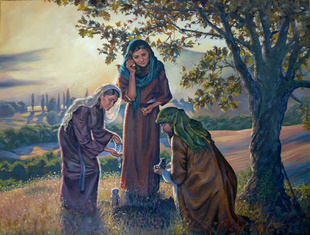
So, back to a specific story. One of my recent paintings is of the widow of Zarephath. In this case, I was ready to begin my next project and, after much prayer, I felt that I needed a subject that would embody service. Many of my leaders, family, and friends helped me as I searched the scriptures. It was at a stake training meeting while going through handbooks that my husband quietly pointed out an article by President Monson in the Basic Welfare pamphlet subtitled “Motivated by Faith,” about the story of the widow giving her last cake of bread to Elijah. Once again I felt something inside me agree that this was my next subject. And in the next class I attended, I identified almost immediately the perfect sister to portray her. Inspiration may not always move so quickly as this example, but it’s a blessing when it does!
Is there a particular piece that you consider your personal best? Why?
To me, my paintings are like my children—I’ve put much of my time, emotions, and effort into them and I could never choose one above the rest. The only difference is that my real children are masterpieces in progress…I hope.
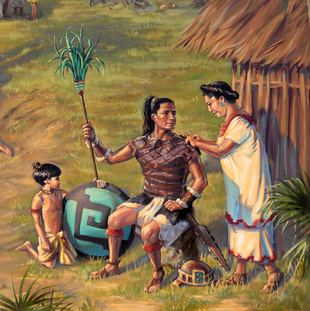
How have you been able to balance being a wife, mother and artist?
Well, I did have to stop three times during this interview to do the laundry, for one thing. My feelings are that my children will only be young once, and Mark and I didn’t choose to have children just to have other people raise them. It may be hard sometimes for me to see other artists blossom in their talent, spending every day in a big studio and producing tons of art every year compared to my measly few. But I find assurance that there is a time and a place for all things. My husband and boys are terrific at supporting me and scheduling our vacations around places that I can paint landscapes, or surviving off of granola bars for a week because “Mommy’s downstairs painting,” etc. But I feel like my “mom,” “wife,” and even “Sister Rieker” time I spend now is time in the bank for painting later. And if not, then perhaps that’s just God’s plan for me, and I’m still happy with the balance as it stands.
What is your artistic process?
Not counting photo or live sessions with models, here’s my basic process:
Determine size of canvas through sketches then make a final (large) sketch on newsprint the same size as my canvas.
Prep canvas by mixing dry pigments with gesso (lately burnt sienna is my favorite) and sanding between layers.
Rub charcoal on back of my final sketch and trace onto the canvas. Or, if I’m painting a landscape outside, I just sketch in a medium tone color of oils.
Decide and make my color palette (limited, bright, warm, etc.) according to the mood I want to achieve.
With my biggest brushes, lay in the darkest colors first, working my way up to lighter colors and smaller brushes. Pure white and details are very last. And I never use black! It may sound simple, but this is the process that may take me a couple of months.
Look at it in a mirror to check balance, ask family and friends for critiques, then leave it alone for a week or two before deciding if it’s done and signing it.
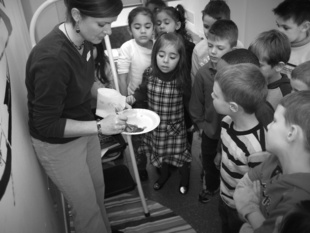
How has your faith and knowledge of the gospel influenced your work?
It permeates everything! My faith and beliefs are so much a part of me that I don’t think I could separate them. Even while I take photos of landscapes in Tuscany or Switzerland, I’m thinking of how the gospel can relate to the beauties around me—from the thorny weeds to the majestic mountains. Knowledge of the gospel lets me know that the purpose for my work is to uplift others. There is too much in this world that brings us down. Why would we want to use our talents for anything other than to inspire each other to be more than what we are today?
What other artists or paintings have inspired you?
Being an art teacher, I have many art books weighing down my shelves, but the ones I go to for inspiration are Sargent (for his creamy use of paint), Michelangelo (for portraying the body in a simple yet carved manner), and Bouguereau (for portraits and softness). I also surround myself with our modern-day LDS painters, like Simon Dewey and Greg Olsen (for their mood and soft light) and James Christensen (for deeper meanings and whimsical subjects).
But I would have learned nothing about art if not for the teachers at my high school—Suitland Center for the Arts—especially Dr. Karol Thompson, who knew how to make me work, and teachers at MICA like Sharon Yates—a phenomenal painter who would get in my face and say, “Do you really want to learn how to paint? Then scrape off your whole painting and do it again three inches to the left.” These teachers taught me that what ends up on the canvas is only the by-product of my learning and searching.
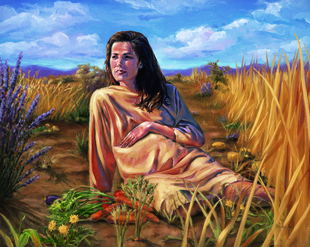
How have you been able to balance being LDS and being an artist?
Good question. When I was in college the thing that got everyone excited was “shock art”—which is to say, anything that would grab the viewer’s attention for both positive or (more often) negative effect. The Young Women’s motto about “standing as a witness at all times, in all things, and in all places” comes to mind. While other artists may be trying to out-shock each other or something similar, I find stability and comfort in my beliefs. The only being I wish to impress is my Heavenly Father. Anyone else is icing on the cake—it’s nice, but not necessary.
How do you see your art helping build the kingdom?
I hope by inspiring others—especially women—to rise to the occasion. To use the things they have been blessed with to help others. Each of the women I’ve portrayed symbolizes a virtue that we all strive for: charity, leadership, humility, patience, etc. The stories that come out of the “Women of Inspiration” series show that these women only overcame adversity because they already had a store of faith to sustain them. If there is one main thought throughout these paintings that would be it. We can endure all things with faith. ❧
